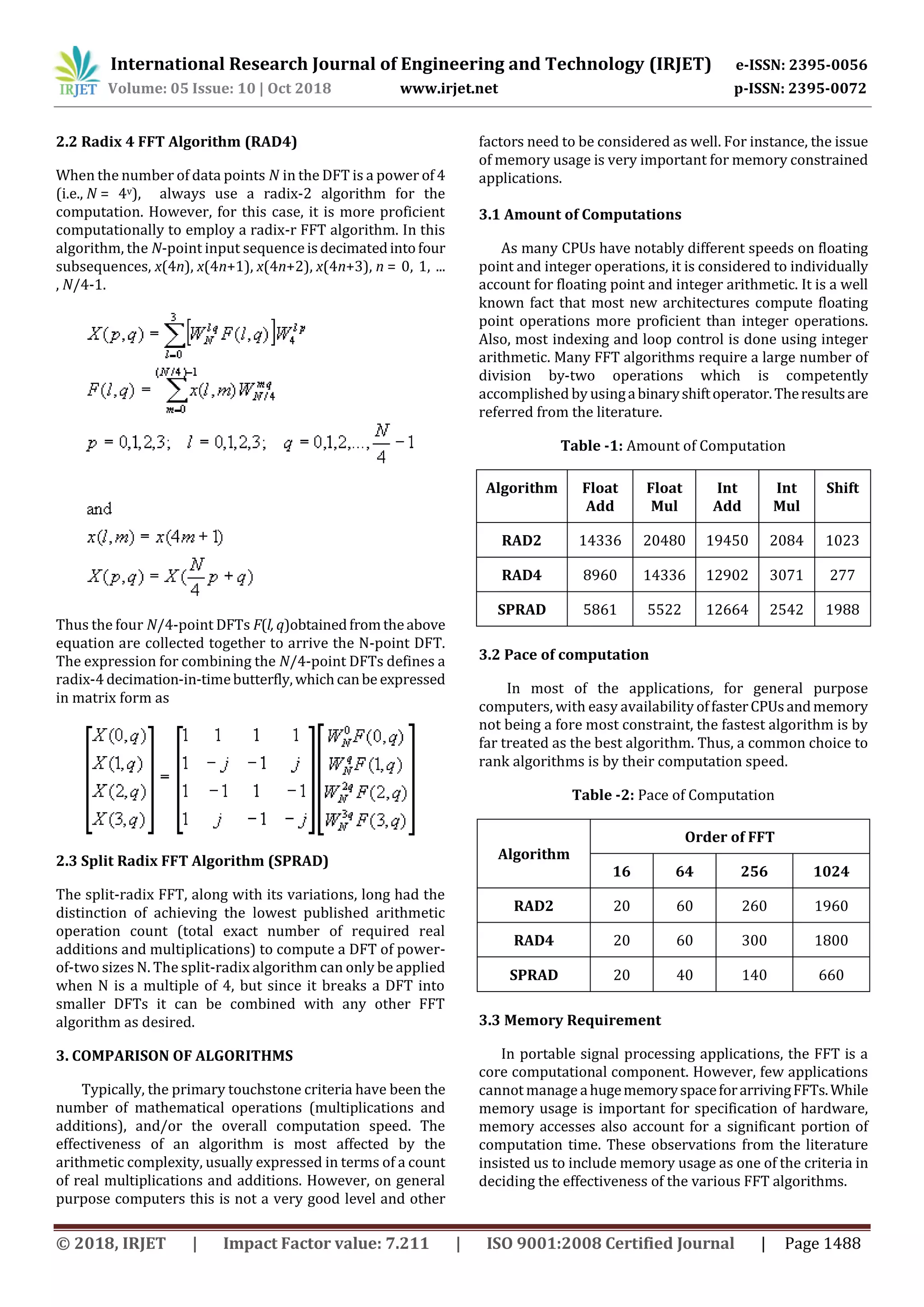This document analyzes and compares several algorithms for computing the Fast Fourier Transform (FFT), including Radix-2, Radix-4, and Split Radix algorithms. It examines each algorithm in terms of the amount of computations required, computation speed, and memory requirements. The Radix-4 algorithm requires the fewest floating point additions and multiplications, while the Split Radix algorithm has the fastest computation speed, especially for larger data sizes. However, all three algorithms have similar memory requirements. In general, the choice of best algorithm depends on the specific constraints of the application, such as available memory or need for computational speed.
![International Research Journal of Engineering and Technology (IRJET) e-ISSN: 2395-0056 Volume: 05 Issue: 10 | Oct 2018 www.irjet.net p-ISSN: 2395-0072 © 2018, IRJET | Impact Factor value: 7.211 | ISO 9001:2008 Certified Journal | Page 1487 A Study on Algorithms for FFT computations Saravanakumar Chandrasekaran1, Dr.G.Themozhi2 1Assistant Professor, Department of ECE, Valliammai Engineering College, Tamil Nadu 2Professor and Head, Department of ECE, Tagore Engineering College, Tamil Nadu ---------------------------------------------------------------------***---------------------------------------------------------------------- Abstract:- The Fast Fourier Transform is an qualified algorithm for computing the Discrete Fourier Transform in terms of reduced number of computations than that of direct evaluation of DFT. It has several applications in signal processing for frequency transformations. Because of the complexity of the FFT algorithm, recently various FFT algorithms have been proposed to meet real – time processing requirements and to reduce hardwarecomplexityoverthelast decades. So it is of considerable interest to researchers of signal processing technology to compare these algorithms. In this paper, a general analysis and comparison of the FFT algorithms is crisply done. The analysis of each algorithm includes the pace of the computation, amountofcomputations and memory requirements. Key Words: Fast Fourier Transform, Complexity, Comparison, Algorithm, Memory. 1. INTRODUCTION A sufficient number of FFT algorithms have been developed earlier for the efficient computation of the DFT. The first major breakthrough was the Cooley-Tukey algorithm [1] developed inthemid-sixtieswhichresultedina flood of works on FFTs. This algorithm reduced the complexity of a DFT fromO(N)toO(NlogN),whichatthetime wasaincredibleimprovementinefficiency.Algorithmswhich followed have achieved this complexity reduction to varying degrees. The Cooley-Tukey algorithm was a Radix-2 algorithm. The next few radixalgorithmsdevelopedwerethe Radix-3, Radix-4, and the Mixed Radix algorithm. Further research led to the Fast Hartley Transform (FHT) and the Split Radix (SPRAD) algorithm In this paper, from the literature we analyze each algorithm under a variety of constraints, and to use the statistics to create a best solution for the computation of FFT based on the constraints. 2. ALGORITHM 2.1 Radix 2 FFT Algorithm (RAD2) In computation of the N = 2n point DFT by the divide-and conquer approach., split the N-point data sequence into two N/2-point data sequences a1(n) and a2(n), corresponding to the even-numbered and odd-numbered samples of x(n), respectively, that is, a1(n) = x(2n) a2(n) = x(2n +1) , n = 0, 1,…..(N/2 – 1) Thus a1(n) and a2(n) are obtained by decimating x(n) by a factor of 2, and hence the resulting FFT algorithm is called a decimation-in-time algorithm. Now the N-point DFT can be expressed in terms of the DFT's of the decimated sequences as follows: But WN 2 = WN/2. With this substitution, the equation can be expressed as where F1(k) and F2(k) are the N/2-point DFTs of the sequences f1(m) and f2(m), respectively. Since F1(k) and F2(k) are periodic, with period N/2, we have F1(k+N/2) = F1(k) and F2(k+N/2) = F2(k). In addition, the factor WN k+N/2 = -WN k. Hence the equation may be expressed as It is observed that the direct computation of F1(k) requires (N/2)2 complex multiplications. It is also common to the computation of F2(k). Furthermore, thereare N/2additional complex multiplications required to compute WN kF2(k). Hence the computation of X(k) requires 2(N/2)2 + N/2 = N 2/2 + N/2 complex multiplications. This initial step fallout in a reduction of the number of multiplications from N2 to N 2/2 + N/2, which is about a factor of 2 for N large.](https://image.slidesharecdn.com/irjet-v5i10283-181105065641/75/IRJET-A-Study-on-Algorithms-for-FFT-Computations-1-2048.jpg)

![International Research Journal of Engineering and Technology (IRJET) e-ISSN: 2395-0056 Volume: 05 Issue: 10 | Oct 2018 www.irjet.net p-ISSN: 2395-0072 © 2018, IRJET | Impact Factor value: 7.211 | ISO 9001:2008 Certified Journal | Page 1489 Table -3: Memory Requirements Algorithm Memory Requirement (Bytes) RAD2 72240 RAD4 72536 SPRAD 72508 4. CONCLUSIONS The amount of computation is graphically given below. The different arithmetic are compared. Chart -1: Amount of Computation For Shift operations, RAD 4 algorithm is best option if the constraint is number of computations. The pace of the computationreveals that SPRADalgorithmis best among the three. Chart -2: Pace of Computation The memory requirements are distributed equally for all the three algorithms. Chart -3: Memory Requirements REFERENCES [1] Manish Sone, Padma Kunthe, “A General comparison of FFT algorithms”, Cypress Semiconductors [2] J.W. Cooley and J.W. Tukey, (1965), An Algorithm for Machine Computation of Complex Fourier Series, Mathematical Computation, vol. 19, pp. 297-301. 2. R.N. Bracewell, (1985), TheHartleyTransform,OxfordPress, Oxford, England. [3] R.N. Bracewell, (1984), Fast Hartley Transform, Proceedings of IEEE, pp. 1010-1018. [4] H.S. Hou, (1987), The Fast HartleyTransformAlgorithm, IEEE Transactions on Computers, pp. 147-155, February. [5] P. Duhamel and H. Hollomann, (1984), Split Radix FFT Algorithm, Electronic Letters, vol. 20, pp.14-16,January [6] C.S. Burrus and T.W. Parks, (1985), DFT/FFT and Convolution Algorithms: Theory and Implementation, John Wiley and Sons, New York, NY, USA.](https://image.slidesharecdn.com/irjet-v5i10283-181105065641/75/IRJET-A-Study-on-Algorithms-for-FFT-Computations-3-2048.jpg)